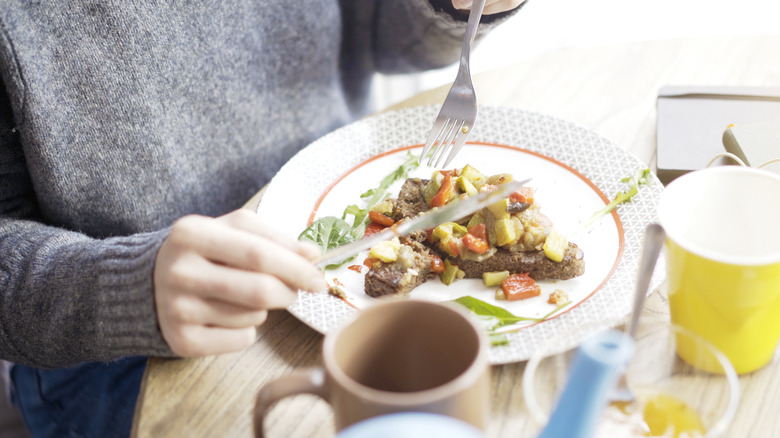What Is A Tartine?
We may receive a commission on purchases made from links.
There's bread, there's toast, sandwiches, fillings, bruschetta, and open-faced toasty wonders piled high with endless ingredients. Are they all just simple sandwich variations, with bread serving as the base or wrapping? Maybe, but not if you give it an intriguing French name like tartine. Suddenly, the concept of crispy bread hosting all kinds of deliciousness gets elevated to the realm of culinary art or haute cuisine.
But perching on a fancy plate, served with Parisian flair, doesn't explain how tartines deserve such exclusivity and devotion. Entire eateries and bakeries get named after or devoted to the form, from La Tartine in Paris to Tartine Bakery in San Francisco. At its core, a tartine is indeed just an open-faced sandwich, meaning a single slice of bread with toppings. It's the imaginative subtleties of creating one that distinguishes it from ordinary lunch or breakfast fare.
From the type of bread to how it's toasted, which edibles are included, and when it's eaten, the art of tartine building is yours to master. Personalizing per your own taste proclivities is even better.
Importance of the bread in tartine creation
Make no mistake: Bread is the bedrock of an artsy French tartine — and it must be the right kind. Bread serves as the base upon which everything stands, so a sturdy composition is crucial. Favorite options for tartine-masters include the common French loaf or baguette, cut lengthwise from end to end to provide a firm base for building your masterpiece. Many chefs prefer fresh-baked rustic country bread, which tends to have a thick crust and tight inner texture.
What's known as artisan breads are generally ideal for French-style tartines, evidenced by cookbooks such as "Tartine" by author and baker Chad Robertson, who co-owns Tartine Bakery in San Francisco. A sourdough rye bread works well for Scandinavian and other regional tartine specialties, such as the European Smørrebrød, a Danish version of tartines. It's important that the bread holds up well under the weight of elaborate tartine construction and eating. Toasting the bread helps guard against sogginess when the ingredients are artfully placed into position.
However, a morning tartineoften uses a slightly softer bread such as challah, brioche, or various white breads. That's because breakfast tartines can be as simple as toasted bread slices with butter, served with jam or fruit spreads, requiring less bulk than afternoon or evening ones. The softer, more absorbent breads also complement the morning practice of tartine dipping in which the tartine gets dunked into toasty hot chocolate, tea, or steaming coffee drinks.
Making your own custom tartines
Tartines are a creative chef's dreamscape, an open bread palette just waiting for edible colors, textures, and tastes. Pretty much anything goes as far as ingredients. As you would in any freestyle food creation, pay attention to how each component balances the other. Sweet or savory, soft, hearty, condiments, spicy oils, proteins, vegetables, cheeses — it's all on the table, literally.
To get started, try familiar things and add your own touches. For example, did you realize that avocado toast and bruschetta are essentially tartines? So pile on more of your favorite items. Try cheeses, deli meats, pancetta, thinly sliced veggies, capers, roasted asparagus or squash, diced eggs, caviar, shaved roast beef, scrambled eggs, kale — or whatever strikes your fancy. Seafood is an excellent choice, especially grilled shrimp or smoked salmon with cream cheese.
Starting with a primary layer of soft spreadable cheese, hummus, mayonnaise, olive oil, or similar helps keep things in place as you layer upward. Spices and herbs add flavor, as do hot sauces, pepper flakes, lemon juice, or chili paste. A favorite French addition to afternoon tartines is pâté. For dessert tartines, try tart apple slices with honey or figs with drizzled chocolate.
Holidays bring in a host of other tartine opportunities. Some religious observations, such as Passover, can utilize unleavened matzo bread to make easy tartines such as the smoked trout, beet, and radish tartine shared by chef Justin Chapple, host of the video series "Mad Genius Tips."
How to eat a tartine
In keeping with its elegant European name, the tartine comes with its own set of cultural practices and etiquette. While you can simply pick up this upscale toast with your hands and bite into it as you would any other sandwich, the proper approach calls for using a fork and knife to politely slice and skewer small pieces. Breaking out your silverware may seem excessively formal, but this method is not just a matter of manners — it's also functional. Tartines are more substantial than your average toast; they also have a less protective structure than a sandwich, so they can be too unwieldy to lift from the plate without making a mess.
Since a tartine is meant to be a meal in itself, it can be layered high with all kinds of ingredients in different shapes, sizes, and textures. A prosciutto and cucumber tartine, for example, has silky strips of meat and crunchy rounds of vegetables, which are delicious together but challenging to neatly nibble. The fork and knife technique prevents the toppings from sliding off, and allows you to build more manageable bite-sized portions.




